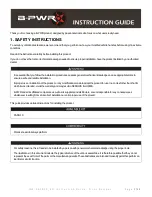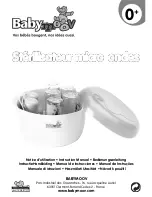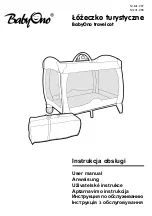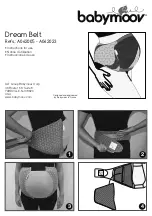
Speedkid
Speedkid
Subject to change without notice.. – 12 | 2020 –
69
68
– 12 | 2020 – Subject to change without notice.
Care and maintenance
After every use
»
Clean the inside of the cabin.
»
Pay attention to coarse dirt and remove it immediately if possible.
After use in harsh weather conditions
»
Clean the inside and outside of the cabin thoroughly.
»
Care for all sliding or moving parts with silicone spray.
»
Only fold up the cabin after it has been cleaned and is completely dry.
When not in use
»
Store the
Speedkid
only in places where the storage temperature falls within the range of
-23 °C to maximum 65 °C.
»
The trailer should only be stored folded when completely dry.
»
The storage location should be dry, well ventilated and protected against direct sunlight.
»
At higher storage temperatures, you should store the wheels separately from the cabin
because the tyres’ rubber can cause odours.
»
Use a Qeridoo folding garage if the
Speedkid
must be kept outdoors.
Caution!
Please note that when using the optional folding garage the trailer must be
completely dry.
Caution!
Replace corroded steel and aluminium parts immediately. Never bend back
deformed or bent aluminium parts (risk of breakage). Replace bent aluminium
parts immediately. Immediately replace plastic parts that have become porous or
fragile due to the effects of the weather, for example.
Before every ride
»
Check that the wheels are secure. The push-in axles must be engaged in the axle mount and
it must not be possible to pull them off without pressing the rubber cap.
»
Check the air pressure in the wheels. It should be in the range of 2.5 – 3 bar.
»
Check the air pressure of the buggy wheel (maximum air pressure: 1.9 bar).
»
Check the total weight, including children and baggage.
»
Check the fasteners of the cover and close them if necessary.
»
Inspect all harnesses under the cabin to make sure that they are secure. They must be firmly
tightened to hold the cover and backrest securely.
»
Trailer mode: Make sure that the buggy wheel has been removed and that the requirements
described in the chapter
„Connecting the trailer to a bicycle“ on page 63
have been fulfilled.
»
Buggy mode: Make sure that the buggy wheel can rotate freely. Put the hand strap of the
push handle around your wrist in order to prevent accidental rolling away.
»
Jogger mode: Make sure that the buggy wheel is secured facing straight ahead. Put the hand
strap of the push handle around your wrist in order to prevent accidental rolling away.
»
Check whether the tow bar, coupler and buggy wheel and their attachments are technically OK.
»
Check the condition of the wheels. Replace covers and hoses in good time.
Maintenance intervals
Care and maintenance
Monthly (or every 200 km)
»
Check the textile cover, all fasteners, the seats and the safety harnesses for cracks, wear and
missing parts.
»
Inspect all frame tubes and all connecting pieces and fastening components for signs of
wear and damage.
»
Check that all screw and cotter pin connections are secure.
»
Clean the removable axles of the wheels.
Semi-annually (or every 500 km)
»
Care for all sliding and moving parts with silicone spray.
»
Clean the inside and outside of the cabin thoroughly.
»
Check that all screw and cotter pin connections are secure.
Every three years (or every 3.000 km)
»
Have a full inspection carried out by a specialist workshop no later than every three years.
Every two years (or every 2.000 km)
»
Replace the leaf springs as they are a wearing part.
Every four years (or every 5.000 km)
»
Change the thru axle.
»
Non-rechargeable batteries must not be charged.
»
Remove rechargeable batteries from the item before charging them.
»
Different types of batteries as well as old and new batteries must not be used together on
the same item.
»
Only batteries of the same or equivalent type as specified should be used.
»
Please make sure that the batteries are inserted with the correct polarity.
»
The supply terminals must not be short-circuited.
»
Remove empty batteries from the item.
»
It is not allowed to burn empty batteries as they might explode or leak.
General instructions for batteries
Information concerning the disposal of exhausted batteries
The pictured symbol on the left side on batteries, the packing or the enclosed
documents signifies that the batteries should not be disposed of at the end of their
life cycle together with the domestic waste. Possible added letters under the waste
bin signify that the battery contains lead (Pb), cadmium (Cd) or mercury (Hg). You
as consumer are obliged by law to render all kind of batteries (both rechargeable
as well as non-rechargeable) inclusive button cells at local places of collection or
at the retail market. This is at no charge. The proper disposal enables the recycling
of valuable resources and avoids possible negative effects on humans and the
environment.
The pictured symbol on the product, the packing or the enclosed documents signifies
that the product should not be disposed of after the end of its life cycle together
with the domestic waste. You as consumer are obliged by law to render electric and
electronic products at a local place of collection for electronic equipment. This is at
no charge. Please take out the batteries before disposal of the product. The proper
disposal enables the recycling of valuable resources and avoids possible negative
effects on humans and the environment. For further information please contact
your local authority or the vendor of the product.
Information concerning the disposal of old electric and electronic products





































